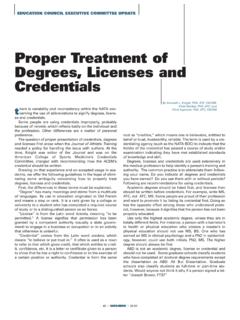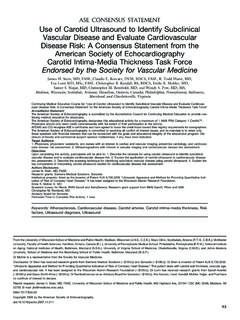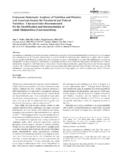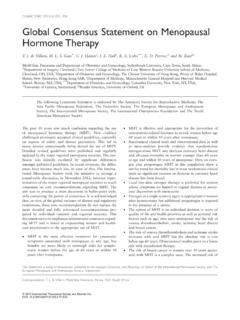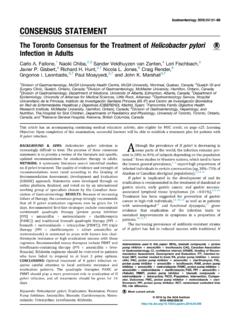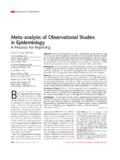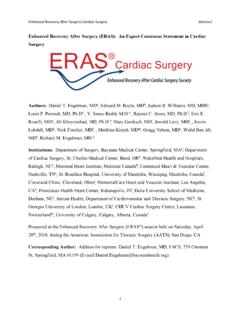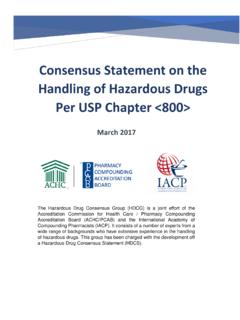Transcription of Consensus statement on concussion in sport the …
1 1 McCrory P, et al. Br J Sports Med 2017;0:1 10. statement on concussion in sport the 5th international conference on concussion in sport held in Berlin, October 2016 Paul McCrory,1 Willem Meeuwisse,2 Ji Dvorak,3,4 Mark Aubry,5 Julian Bailes,6 Steven Broglio,7 Robert C Cantu,8 David Cassidy,9 Ruben J Echemendia,10,11 Rudy J Castellani,12 Gavin A Davis,13,14 Richard Ellenbogen,15 Carolyn Emery,16 Lars Engebretsen,17 Nina Feddermann-Demont,18,19 Christopher C Giza,20,21 Kevin M Guskiewicz,22 Stanley Herring,23 Grant L Iverson,24 Karen M Johnston,25 James Kissick,26 Jeffrey Kutcher,27 John J Leddy,28 David Maddocks,29 Michael Makdissi,30,31 Geoff Manley.
2 32 Michael McCrea,33 William P Meehan,34,35 Sinji Nagahiro,36 Jon Patricios,37,38 Margot Putukian,39 Kathryn J Schneider,40 Allen Sills,41,42 Charles H Tator,43,44 Michael Turner,45 Pieter E Vos46 Consensus statementTo cite: McCrory P, Meeuwisse W, Dvorak J, et al. Br J Sports Med Published Online First: [please include Day Month Year]. Additional material is published online only. To view please visit the journal online (http:// dx. doi. org/ 10. 1136/ bjsports- 2017- 097699)For numbered affiliations see end of toDr Paul McCrory, The Florey Institute of Neuroscience and Mental Health, Heidelberg 3084, Victoria, Australia; paulmccrory@ icloud.
3 ComAccepted 6 March 2017 PREAMBLEThe 2017 concussion in sport Group (CISG) Consensus statement is designed to build on the principles outlined in the previous statements1 4 and to develop further conceptual understanding of sport -related concussion (SRC) using an expert Consensus -based approach. This document is devel-oped for physicians and healthcare providers who are involved in athlete care, whether at a recre-ational, elite or professional level. While agreement exists on the principal messages conveyed by this document, the authors acknowledge that the science of SRC is evolving and therefore individual management and return-to-play decisions remain in the realm of clinical Consensus document reflects the current state of knowledge and will need to be modified as new knowledge develops.
4 It provides an overview of issues that may be of importance to healthcare providers involved in the management of SRC. This paper should be read in conjunction with the systematic reviews and methodology paper that accompany it. First and foremost, this document is intended to guide clinical practice; however, the authors feel that it can also help form the agenda for future research relevant to SRC by identifying knowledge series of specific clinical questions were devel-oped as part of the Consensus process for the Berlin 2016 meeting. Each Consensus question was the subject of a specific formal systematic review, which is published concurrently with this summary state-ment.
5 Readers are directed to these background papers in conjunction with this summary statement as they provide the context for the issues and include the scope of published research, search strategy and citations reviewed for each question. This 2017 Consensus statement also summarises each topic and recommendations in the context of all five CISG meetings (that is, 2001, 2004, 2008, 2012 as well as 2016). Approximately 60 000 published articles were screened by the expert panels for the Berlin meeting. The details of the search strategies and findings are included in each of the systematic details of the conference organisation, methodology of the Consensus process, question development and selection on expert panellists and observers is covered in detail in an accompanying paper in this A full list of scientific committee members, expert panellists, authors, observers and those who were invited but could not attend are detailed is at the end of the summary document.
6 The International Committee of Medical Journal Editors conflict of interest declaration for all authors is provided in Appendix are encouraged to copy and freely distribute this Berlin Consensus statement on concussion in sport , the concussion Recognition Tool version 5 (CRT5), the Sports concussion Assessment Tool version 5 (SCAT5) and/or the Child SCAT5. None of these are subject to copy-right restriction, provided they are used in their complete format, are not altered in any way, not sold for commercial gain or rebranded, not converted into a digital format without permission, and are cited legal considerationsThe Consensus statement is not intended as a clin-ical practice guideline or legal standard of care, and should not be interpreted as such.
7 This document is only a guide, and is of a general nature, consistent with the reasonable practice of a healthcare profes-sional. Individual treatment will depend on the facts and circumstances specific to each individual case. It is intended that this document will be formally reviewed and updated before 31 December AND ITS MANAGEMENTThe paper is laid out following the CISG s 11 R s of SRC management to provide a logical flow of BJSM Online First, published on April 27, 2017 as Article author (or their employer) 2017. Produced by BMJ Publishing Group Ltd under licence. on April 27, 2017 - Published by from 2 McCrory P, et al.
8 Br J Sports Med 2017;0:1 10. statementclinical concussion management. The new material recommen-dations determined at the Berlin 2016 meeting are italicised, and any background material or unchanged recommendations from previous meetings are in normal sections are: Recognise; Remove; Re-evaluate; Rest; Rehabilitation; Refer; Recover; Return to sport ; Reconsider; Residual effects and sequelae; Risk is the definition of SRC?In the broadest clinical sense, SRC is often defined as representing the immediate and transient symptoms of traumatic brain injury (TBI). Such operational definitions, however, do not give any insights into the underlying processes through which the brain is impaired, nor do they distinguish different grades of severity, nor reflect newer insights into the persistence of symptoms and/or abnormalities on specific investigational modalities.
9 This issue is clouded not only by the lack of data, but also by confusion in definition and terminology. Often the term mild traumatic brain injury (mTBI) is used interchangeably with concussion ; however, this term is similarly vague and not based on validated criteria in this key unresolved issue is whether concussion is part of a TBI spectrum associated with lesser degrees of diffuse structural change than are seen in severe TBI, or whether the concussive injury is the result of reversible physiological changes. The term concussion , while useful, is imprecise, and because disparate author groups define the term differently, comparison between studies is problematic.
10 In spite of these problems, the CISG has provided a consistent definition of SRC since Berlin expert panel modified the previous CISG defini-tion as follows: sport related concussion is a traumatic brain injury induced by biomechanical forces. Several common features that may be utilised in clinically defining the nature of a concussive head injury include: SRC may be caused either by a direct blow to the head, face, neck or elsewhere on the body with an impulsive force transmitted to the head. SRC typically results in the rapid onset of short-lived impairment of neurological function that resolves spontaneously.
